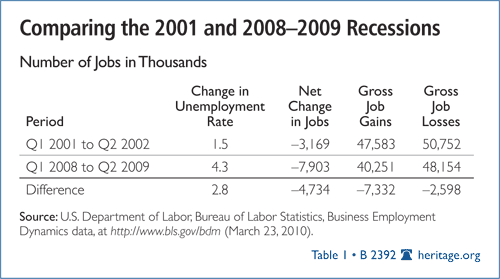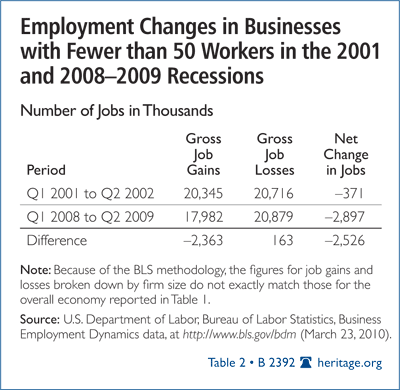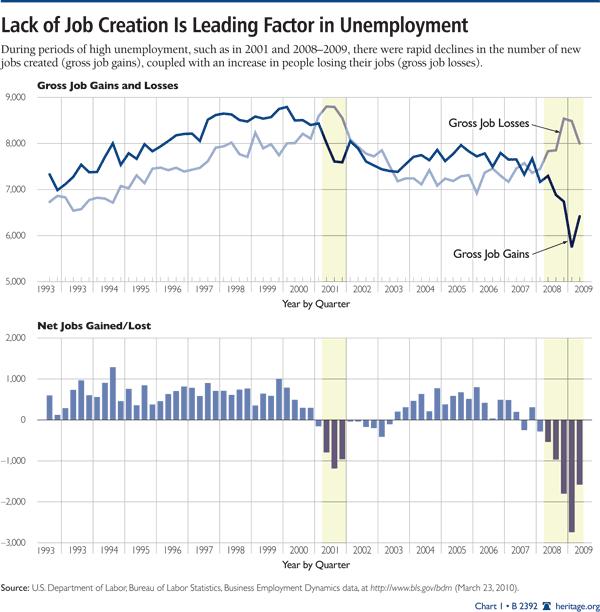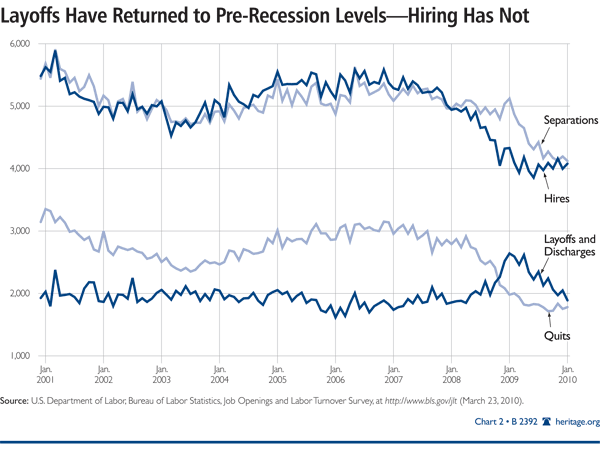Abstract: While layoffs increased during this recession, they are not the primary cause of the nearly 10 percent unemployment rate. The main factor driving the unemployment rate so high during this recession was, and continues to be, the sharp drop in creation of new jobs. Government spending still does not create jobs or prosperity, either. Washington should finally admit this fact and encourage private-sector investment and entrepreneurship—the best job creators that history has produced.
While unemployment has risen rapidly during this recession, the increase in jobless Americans has not been primarily due to job losses.[1] Employers shed 2.6 million more jobs six quarters into the 2001 recession than they had six quarters (most recent data available) into the current recession. However, unemployment has risen much more in this recession than in 2001.[2] It is the sharp drop in creation of new jobs that explains the severity of this recession. The credit crunch, the collapse of the housing bubble, and harmful economic policies have made the economy less hospitable to entrepreneurs. This bad business climate discourages business owners from expanding.
More government spending, as many in Congress propose, will not reduce unemployment because government spending does not encourage businesses to invest and hire. Congress should instead focus on promoting innovation and entrepreneurship— which promote wealth creation and, consequently, more jobs.
Job Creation Affects Employment More than Job Losses
Unemployment has almost doubled since the recession began in December 2007, rising from 5 percent to a peak of 10.1 percent in October 2009. As of February 2010, unemployment stands at 9.7 percent. Unemployment has risen far more than in most past recessions. Following the 2001 recession, unemployment peaked at 6.3 percent; after the 1990–1991 recession unemployment reached a high of 7.8 percent.
Media coverage of this rising unemployment has focused on job losses. Behind this coverage lies the view that unemployment rises during downturns primarily because firms become more likely to lay off employees. The data, however, do not support this conventional wisdom.
The Bureau of Labor Statistics (BLS) Business Employment Dynamics (BED) data use unemployment insurance (UI) records to measure gross job gains and gross job losses at businesses. Gross job gains are the total increase in jobs at a company over time, and gross job losses are the total decrease in jobs. Almost all private-sector companies must pay UI taxes, so BED data reflect the job market very accurately.
The most recent available BED data are for the second quarter (Q2) of 2009, and cover the quarters in which the highest job losses of this recession occurred.[3]
BED figures show that employers created 7.7 million jobs and shed 7.4 million jobs in the last quarter of 2007—enough net new jobs to keep unemployment steady as new workers entered the labor force. If job creation and job losses had remained at those levels through Q2 2009, employers would have created 5.8 million more jobs and eliminated 4 million fewer jobs than they actually did.[4] Lower job creation accounts for 59 percent of the recession’s decreased employment.
In Q2 2009, gross job losses were 8.7 percent (699,000 jobs) above pre-recession levels, while gross job gains were 16.3 percent (1.4 million jobs) below them. The number of people laid off by companies going out of business rose by 3.8 percent (48,000 jobs), and the number of people hired at newly formed businesses fell by 10.4 percent (235,000 jobs).[5] Unemployment has risen primarily because private-sector job creation has dropped sharply.
More Jobs Lost in 2001 Recession
A surprising fact clearly illustrates the importance of reduced hiring. Table 1 shows the change in the unemployment rate, net employment, gross job losses, and gross job gains through the first six quarters of the 2001 recession and the first six quarters of the 2008–2009 recession.[6]

Employers shed 2.6 million more jobs at this point of the 2001 recession than in the current recession. Job losses were worse then than now. Net employment has fallen more during the current recession because employers have created 7.3 million fewer new jobs than during the 2001 recession.
JOLTS. Decreased hiring is the most important factor driving unemployment up. A survey with more recent data than the BED’s also leads to this conclusion. The BLS’s Job Openings and Labor Turnover Survey (JOLTS) tracks monthly movements of workers between jobs, and is current through January 2010.
In the last three months of 2007, the last quarter before the recession, private-sector employers laid off an average of 1.9 million workers per month. That figure rose to 2.6 million laid-off workers in January 2009, and has since fallen back to 1.9 million workers in January 2010. Layoffs have now returned to their pre-recessionary levels. Hiring has not.
Between the last quarter of 2007 and January 2010, the number of monthly new hires fell from 5.2 million to 4.1 million—a drop of 1.1 million workers.[7] Today, hiring remains well below pre-recessionary rates, while layoffs have returned to normal levels.
The fact that JOLTS data measure movements of workers between existing jobs, not job creation, does complicate the interpretation of these figures. Changes in layoffs and hiring do not directly equate to jobs created and lost because workers have also become less likely to quit their jobs.[8]
Nonetheless, the JOLTS data paint the same picture as the more easily interpreted BED figures, and they confirm the findings of academic research. The main reason why unemployment rises during economic downturns is that job creation falls while the labor force continues to grow, making new jobs harder to find.[9] Those without work remain unemployed longer, driving up the unemployment rate. Research into past downturns suggests that lower job creation will continue to account for most of the net job losses throughout the remainder of this recession.[10]
This trend may seem counterintuitive, and it is not the impression that most people receive from the media. It is also cold comfort to any breadwinner who has just received a pink slip. However, it is nonetheless true and implies distinct policy strategies to reduce unemployment.
Less Investment and Entrepreneurship
Low hiring is primarily a symptom of America’s economic weakness, not its cause. Businesses did not suddenly decide to stop hiring. Rather, economic and political conditions changed in ways that discourage investment and entrepreneurship. Annual private fixed nonresidential investment has fallen by $327 billion since the recession started— a 19 percent drop. Less private investment means less hiring.
What are the factors that lead to reduced investment and fewer new business start-ups? There are now fewer funds available for businesses to invest, and business owners are less confident of their enterprises’ futures.
Fewer Resources to Invest. The housing bubble of the 2000s consumed huge quantities of capital in housing investments that proved to be worth much less than investors anticipated. Banks and wealthy investors lost hundreds of billions of dollars in bad investments. These funds no longer exist to loan to entrepreneurs. Banks now want to restore their balance sheets and have tightened their lending standards. Lenders have become less risk tolerant, so many business investments go unfunded.
The large expansion of government is also contributing to the problem. The resources the government spends do not materialize out of thin air— they come from the economy. When the government increases spending, it crowds out the resources that business owners could have invested in their enterprises. Private investment falls sharply when government spending rises.[11]
The recession has worsened this effect because most lenders consider the federal government one of the safest investments possible. Many lenders are now loaning to the government rather than to private businesses.[12]
Less Desire to Invest. In the current weak economy, business owners have also become cautious about risking their capital in new enterprises. The policy choices in Washington have contributed to that caution. One in 10 small owners surveyed by the National Federation of Independent Business said that because of the current political climate it is a bad time to expand.[13]
Many items on the congressional agenda—the gargantuan health care legislation that passed on March 21, cap-and-trade regulations of CO2 emissions, and abolishing private ballots for union organizing—would significantly raise taxes and business costs. In addition, enormous increases in federal spending raise the prospects of yet higher taxes and rapidly rising inflation.
In the face of such a threatening environment it is not surprising that many companies are making only the most critical investments. They are choosing to wait and see what Congress passes into law, and whether their business projects will still be viable, before investing their capital in risky projects. This caution, however, means less investment and fewer new jobs.
Small Business Hiring Stalled. These combined factors have particularly affected small businesses. Large corporations denied bank credit can raise funds through issuing debt or equity. Small businesses cannot do this—they rely on banks to finance investments. Small businesses also have less room to absorb the cost of additional regulations or taxes.

Unsurprisingly, then, small business hiring has dropped much more sharply than in the past. During the 2001 recession, net employment by small businesses fell by 371,000 jobs. That figure constituted relatively little (11.8 percent) of the total job losses in that downturn. In this recession, however, small business employment has fallen by a staggering 2.9 million jobs. Small businesses now account for 35.8 percent of job losses in this downturn—triple the 2001 amount.[14]
As with the overall economy, changes in hiring explain virtually all of the difference in severity between the two recessions. Failed or contracting small businesses have shed 163,000 more jobs than in 2001. New or expanding small businesses have added 2.4 million fewer employees. Small business hiring has plunged much more than during previous downturns, making this recession significantly more painful.
Government Spending Is Not the Answer
Many congressional “jobs bills” attempt to solve the problem of low private hiring by increasing government hiring. This approach has historically failed for two reasons.
First, government spending does not encourage private entrepreneurship or investment. Government highway construction, for example, while funding construction jobs, does not address the underlying factors that discourage investment.
Second, the resources the government spends do not materialize out of thin air—they are taken from the private sector. Each dollar the government borrows is one less dollar that entrepreneurs can borrow to fund new operations or that private consumers can spend. Research shows that government spending crowds out private investment. Each $1 increase in government spending reduces private-sector investment by between $0.46 and $0.97 after two years, and $0.74 and $0.95 over five years.[15] Government spending substitutes for private-sector investment; it does not supplement it. Increased government spending will further reduce private-sector investment, making the problem of low job creation worse.
This is why countries in which the government spends heavily to create jobs—such as France and Germany—do not enjoy higher employment rates. In fact, the opposite is true. Countries with greater government spending and with larger public-sector payrolls have higher unemployment.[16] Government spending eliminates more jobs than it creates.
The Answer? Create a Better Business Climate
If the Members of Congress want to increase investment and hiring, they should create a better climate for entrepreneurs and businesses. Reducing business costs and risks will spur investors and entrepreneurs to invest their money and efforts in new enterprises. As they do so, they will create new, lasting jobs. Congress should treat the underlying problem of a weak economy, not simply the symptom of unemployment.
One of the best ways for Congress to encourage business investment is by reducing the corporate tax rate—America has one of the highest corporate tax rates in the developed world. Businesses take account of the opportunity cost of using capital. Reducing the business tax rate increases after-tax returns on investment. As a result, lower corporate taxes would encourage businesses to invest in projects whose after-tax return would then exceed their cost of capital. Businesses would respond to lower taxes by investing in new and expanded operations. That is what creates jobs. Heritage Foundation analysts have found that reducing the corporate tax rate from 35 to 25 percent, while keeping the capital gains tax at 15 percent, would create an average of at least 2 million jobs a year over the next decade.[17]
No-Cost Stimulus. Given the current size of the deficit, Congress may consider such tax relief unaffordable. But Congress could pass many other policies to promote entrepreneurship and wealth creation without adding to the deficit. Such a no-cost stimulus would:
Freeze all proposed tax hikes and costly regulations until unemployment falls below 7 percent;
Freeze spending and rescind unspent stimulus funds;
Reform business regulations, such as repealing Section 404 of the Sarbanes–Oxley Act in order to reduce excessive auditing costs;
Reform the tort system to lower costs and uncertainty facing businesses;
Remove barriers to domestic energy production in Alaska and the Outer Continental Shelf;
Repeal the job-killing Davis –Bacon Act;
Pass the pending free-trade agreements with South Korea, Colombia, and Panama; and
Reduce taxes on companies’ foreign earnings if they repatriate those earnings to the United States.
Conclusion
The unemployment rate has nearly doubled since the recession began. Congress should understand that increased layoffs are not the main reason unemployment has risen; layoffs were worse in the 2001 recession. The main factor increasing unemployment has been businesses cutting back on investment and entrepreneurs starting fewer companies. Consequently, they have created fewer jobs.
Businesses have cut back on investing because funds have become less available and because they have less certainty about the future economic climate. To increase job creation, Congress must treat the disease, not manage the symptoms. Government hiring will not spur private investment—it will crowd it out. Congress should instead promote private-sector investment and entrepreneurship— which promote wealth creation.
—James Sherk is Senior Policy Analyst in Labor Economics in the Center for Data Analysis at The Heritage Foundation.




